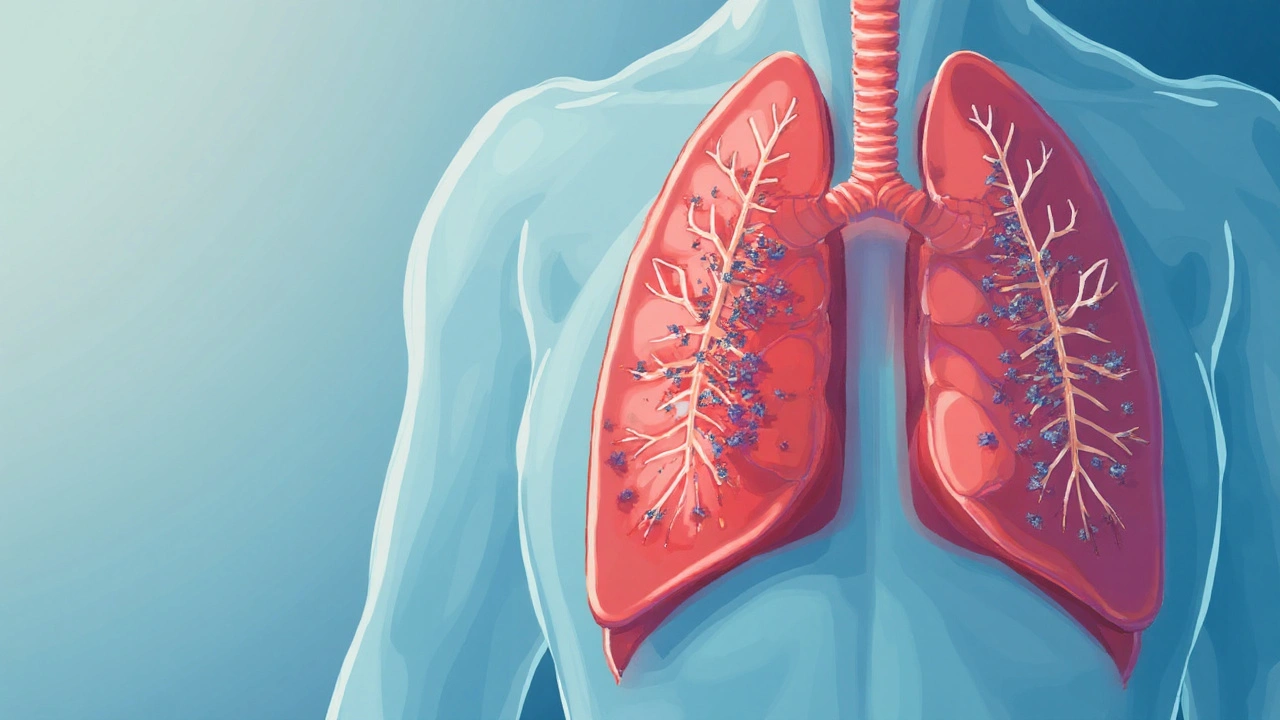Allergic asthma is a chronic respiratory condition characterised by airway inflammation that is directly triggered by allergens, especially those that appear seasonally such as pollen or mold spores. When the immune system over‑reacts to these airborne particles, the airways tighten, produce excess mucus and become hyper‑responsive, making breathing difficult. This link between seasonal allergies and asthma is the focus of the article.
Seasonal allergies: more than a runny nose
Seasonal allergies (also known as allergic rhinitis) is an immune‑mediated response to airborne allergens that typically peaks in spring, summer or autumn. Common culprits include tree pollen, grass pollen and weed pollen. Symptoms range from sneezing and itchy eyes to nasal congestion and post‑nasal drip. For many, the irritation stays confined to the upper airway, but in a sizable group it spills over into the lower airway, sparking asthma symptoms.
Asthma: the broader picture
Asthma is a chronic disease of the lungs marked by reversible airway obstruction, bronchial hyper‑responsiveness and underlying inflammation. While triggers vary-from cold air to exercise-one of the most prevalent triggers is an allergic response. About 60% of adult asthma cases have an allergic component, making the overlap with seasonal allergies a major public‑health concern.
How allergens ignite asthma: the biology
The cascade starts when inhaled pollen or dust mites meet the immune system. IgE antibodies are specialised proteins that bind to specific allergens and sit on the surface of mast cells. Upon re‑exposure, these antibodies cause mast cells to release histamine a potent mediator that dilates blood vessels, increases mucus production and irritates nerve endings. Histamine, together with other mediators like leukotrienes, recruits eosinophils white blood cells that infiltrate the airway wall, releasing enzymes that damage tissue and sustain inflammation. The combined effect is airway narrowing and heightened sensitivity - the hallmark of an asthma attack.
Key seasonal triggers
- Pollen Microscopic grains released by trees, grasses and weeds during their flowering periods
- Dust mites Microscopic arthropods that thrive in household fabrics and shed allergenic proteins
- Mold spores, especially in damp basements or after heavy rain
- Late‑season ragweed, notorious for provoking both nose and lung symptoms
Geography matters. In the UK, tree pollen dominates in March‑May, while grass pollen peaks in June‑July. Knowing your local pollen calendar helps anticipate flare‑ups before they cripple your breathing.
Diagnosing the overlap
Doctors use a combination of lung function tests and allergy testing. Spirometry measures forced expiratory volume (FEV1) before and after a bronchodilator dose; a significant improvement suggests reversible airway obstruction. Skin‑prick testing or specific IgE blood panels pinpoint which seasonal allergens provoke the response. When both tests are positive, the diagnosis of allergic asthma is confirmed.

Managing both conditions
Effective control hinges on treating the inflammation at its source and limiting exposure to triggers.
Medication
- Inhaled corticosteroids Anti‑inflammatory agents delivered directly to the airways, reducing eosinophilic activity
- Bronchodilators Quick‑relief drugs such as short‑acting beta‑agonists that relax airway muscles during an attack
- Leukotriene receptor antagonists, which block another inflammatory pathway linked to allergens
Allergen avoidance
Practical steps include keeping windows shut during high‑pollen days, using HEPA filters, washing bedding weekly in hot water, and de‑humidifying indoor spaces to curb dust‑mite growth. Wearing sunglasses outdoors reduces pollen contact with the eyes, often a trigger for reflexive airway constriction.
Immunotherapy
Allergen immunotherapy A long‑term treatment that gradually desensitises the immune system to specific allergens through subcutaneous injections or sublingual tablets. Clinical trials show a 30‑40% reduction in asthma exacerbations after three years of therapy, making it a disease‑modifying option rather than just symptom control.
Allergic asthma vs. non‑allergic asthma
| Attribute | Allergic Asthma | Non‑Allergic Asthma |
|---|---|---|
| Primary trigger | Seasonal allergens (pollen, dust mites) | Cold air, exercise, viral infections |
| Inflammatory cells | Eosinophils, IgE‑mediated | Neutrophils, airway smooth‑muscle hyper‑reactivity |
| Onset age | Childhood to early adulthood | Any age, often later onset |
| Treatment focus | Inhaled steroids + allergen avoidance/immunotherapy | Bronchodilators + trigger control (e.g., cold air) |
| Response to allergy testing | Positive skin‑prick or specific IgE | Negative |
Understanding these distinctions helps clinicians choose the right medication mix and decide whether immunotherapy is worth pursuing.
Related concepts worth exploring
While seasonal allergies and asthma dominate the discussion, they don’t exist in isolation. Consider how air pollution amplifies allergic inflammation, how respiratory infections can act as a catalyst for severe asthma attacks, and how exercise‑induced bronchoconstriction can intersect with allergy‑driven airway narrowing. Each of these topics deepens the picture of respiratory health and offers additional angles for self‑management.
Quick takeaways
- Allergic asthma accounts for roughly 60% of adult asthma cases and is directly linked to seasonal allergens.
- IgE, histamine, and eosinophils drive the inflammatory cascade from nose to lungs.
- Effective control blends inhaled corticosteroids, bronchodilators, allergen avoidance, and, when appropriate, immunotherapy.
- Knowing your local pollen calendar and using indoor air quality measures can prevent many flare‑ups.
- Distinguishing allergic from non‑allergic asthma guides treatment choices and long‑term outcomes.
Frequently Asked Questions
Can I outgrow seasonal allergies and the associated asthma?
Some children see a reduction in allergic rhinitis as they age, but asthma often persists. Long‑term studies show that even when nasal symptoms wane, the underlying airway hyper‑responsiveness can remain, especially if the person continues to be exposed to the same allergens.
Is it safe to use both inhaled steroids and antihistamines together?
Yes. Inhaled corticosteroids target lung inflammation, while antihistamines relieve upper‑airway symptoms. Combining them often improves overall control without significant drug‑interaction risks, provided you follow dosing guidelines.
How long does allergen immunotherapy take to show benefits for asthma?
Most patients notice a reduction in symptoms after 12‑18 months of weekly or monthly injections. Full disease‑modifying effects, such as fewer exacerbations and lower steroid doses, often appear after three years of consistent treatment.
Do over‑the‑counter nasal sprays help prevent asthma attacks?
Nasal corticosteroid sprays can reduce allergic inflammation in the upper airway, which may indirectly lessen lower‑airway triggers. However, they are not a replacement for inhaled asthma medication and should be used as part of a broader management plan.
What lifestyle changes have the biggest impact on seasonal allergy‑related asthma?
Keeping indoor humidity below 50%, using HEPA filters, washing bedding at 60°C weekly, and checking daily pollen counts to adjust outdoor activities are the most effective steps. Pair these with a regular inhaler routine and you’ll see fewer night‑time symptoms.


Melania Rubio Moreno
September 25, 2025 AT 02:27allergic asthma? more like allergic nonsense. i dont even get why we call it asthma if its just allergies acting up. why do we need 5 different meds for something that should just go away when the flowers stop blooming??
Gaurav Sharma
September 26, 2025 AT 01:24It is imperative to note, with the utmost scientific rigor, that the IgE-mediated pathway is not merely a biological curiosity-it is the cornerstone of the entire pathophysiological cascade. To neglect this fact is to invite clinical catastrophe.
Shubham Semwal
September 27, 2025 AT 03:56bro this whole article is just a fancy ad for inhalers. i had allergies for 10 years, never took steroids, just stayed inside during pollen season and drank ginger tea. still breathing. why are doctors so quick to sell you meds?
Sam HardcastleJIV
September 28, 2025 AT 00:20One cannot help but reflect upon the epistemological foundations of modern allergology. Is it not, in essence, a projection of anthropocentric anxiety onto the natural world? The pollen does not seek to harm us-we have simply failed to harmonize with the rhythms of the earth.
Mira Adam
September 28, 2025 AT 15:30Oh please. You think immunotherapy is a miracle? It’s a 3-year money pit that only works if you’re rich, white, and have good insurance. Most people just suffer in silence while pharma laughs all the way to the bank.
Miriam Lohrum
September 28, 2025 AT 18:17It’s interesting how we treat the body as if it’s broken when it’s just trying to protect us. Maybe the problem isn’t the allergens-it’s that our immune systems have forgotten how to relax.
archana das
September 30, 2025 AT 15:31in india we call this 'hawa ki bimari'-illness of the wind. my grandma used to say, 'don't sit near open window when neem tree blooms'. she didn't know about IgE but she knew the truth. simple things work best.
Emma Dovener
September 30, 2025 AT 17:45For anyone with severe seasonal asthma, I highly recommend tracking pollen counts via the American Academy of Allergy, Asthma & Immunology website. Their regional forecasts are surprisingly accurate and free. Also, shower after being outside-pollen sticks to hair and clothes.
Sue Haskett
October 1, 2025 AT 20:44Just a quick note: HEPA filters are NOT optional. They are ESSENTIAL. And washing bedding in HOT water? That’s not a suggestion-it’s a LIFE-SAVER. I used to wake up gasping-now I sleep like a baby. Thank you, science.
Jauregui Goudy
October 3, 2025 AT 06:12Y’ALL. I went from 3 inhalers a day to ZERO after I started immunotherapy. I know it sounds too good to be true, but I cried the first time I ran without wheezing. It’s not magic-it’s medicine. And yes, it’s worth every penny and every needle.
Tom Shepherd
October 3, 2025 AT 08:00wait so dust mites are real? i thought they were a myth like the tooth fairy. also why is ragweed so evil??
Rhiana Grob
October 4, 2025 AT 17:58Thank you for writing this with such clarity. I’ve lived with allergic asthma since I was 8, and this is the first time I’ve seen it explained without fear-mongering or corporate jargon. You’ve given me hope-and a better way to explain it to my kids.